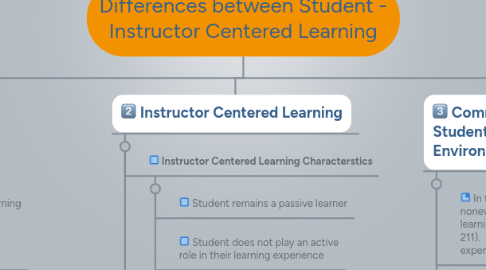
1. Student Centered Learning
1.1. Student Centered Learning Characteristics
1.1.1. “Student-centered learning improves learning to learn and learning how to improve skills such as critical thinking, problem-solving and reflective thinking. Students apply and display different styles.” (ÇUBUKÇU, 2012, p 50).
1.1.2. Develops self-discipline
1.1.3. Instructor becomes more like a COACH
1.1.4. Student and Instructor work together to create the learning experience
1.1.5. “Student-centered learning differs from teacher-centered learning in which it is characterized by the more active role of the learner when compared to the teacher.” (ÇUBUKÇU, 2012, p 50).
1.1.6. Time Management
1.2. Student Centered Learning Benefits
1.2.1. “Student-centered learning helps students to get their own goals for learning, and determine resources and activities guiding them to meet those goals (Jonassen, 2000).” (ÇUBUKÇU, 2012, p 50).
1.2.2. Promotes guided Originality
1.2.3. Students organize schedules
1.2.4. Student develops Time Constraints
1.3. Student Centered Learning Drawbacks
1.3.1. “The student-centered teaching is the arrangement of the teaching experience focusing on the students' responsibilities and activities in the learning process which takes into consideration the students' interests, demands and needs.” (ÇUBUKÇU, 2012, p 49).
1.3.2. Focus is on students ability to be responsible
1.3.3. Must be a good writter
1.3.4. Must want to be challenged
2. Instructor Centered Learning
2.1. Instructor Centered Learning Characterstics
2.1.1. Student remains a passive learner
2.1.2. Student does not play an active role in their learning experience
2.2. Instructor Centered Learning Benefits
2.2.1. Self-discipline is not a key factor to learning experience
2.2.2. Instructor organizes schedule
2.2.3. Instructional environment remains fairly consistent
2.3. Instructor Centered Learning Drawbacks
2.3.1. Teacher Confirmation is too often negotiated
2.3.2. Lack of Encouragement to students can create failure
2.3.3. Students can lack connectedness and never be noticed
2.3.4. Appearances can sway grading perspectives
3. Commonalities to Instruction in both the Student and the Instructor Centered Learning Environment
3.1. In the learning environment “Formative feedback should be nonevaluative, supportive, timely, and specific to improve learning, according to Gosmire et al. (2009).”(LaBarbera, 2013, p 211). Thus, to encourage the student, and promote instructional experience.
3.2. “Research shows that trust is vital for ensuring effective commitments and reducing […] uncertainty (Kramer, 1999; Luhmann, 2000).” (Wang, 2014, p 346).
3.3. References
3.3.1. ÇUBUKÇU, Z. (2012). TEACHERS' EVALUATION OF STUDENT-CENTERED LEARNING ENVIRONMENTS. Education, 133(1), 49-66. (p 49-50).
3.3.2. LaBarbera, R. (2013). The relationship between students' perceived sense of connectedness to the instructor and satisfaction in online courses. Quarterly Review Of Distance Education, (4), 209-220. (p 211).
3.3.3. Wang, Y. D. (2014). Building student trust in online learning environments. Distance Education, 35(3), 345-359. doi:10.1080/01587919.2015.955267 (p 346)
